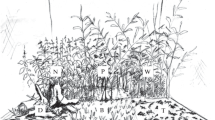Summary
We documented patterns of activity and microhabitat use by breeding male Sage Sparrows (Amphispiza belli) and Brewer's Sparrows (Spizella breweri) in the semiarid shrubsteppe of northwestern U.S.A. to determine how their behavior varies in space and time and how these variations relate to environmental features. In analyses of several sites with multiple plots that were studied for 2–4 yr, the frequencies of activities and substrate use varied significantly with year, plot, and location. The major activities, foraging and singing, varied inversely with one another. Thus, although the general structure of the activity budgets of these species was stable (i.e. foraging and singing were always the most frequent activities), there was considerable variation in the quantitative details of their behavior in space and time. Using stepwise regression, we related these variations in behavior to variations in environmental features such as the densities of the same or other species, the number of species in the community, and coverages of the different substrate types. Few patterns emerged, and those that did were generally not in accord with our expectations. In particular, patterns of substrate use were not related to variations in coverages of those substrates. Sage Sparrows, for example, increased their use of sagebrush and grass with increasing grass coverage and with increasing densities of Sage Sparrows. Responses to both variables suggested nonlinear threshold patterns.
We interpret the variations in behavior as indicating a loose coupling between behavior and proximate environmental conditions for these species. In such situations, the variability of behavior complicates attempts to test ecological hypotheses (e.g. behavioral niche partitioning) with data from a limited number of locations or years.
Similar content being viewed by others
References
Altman J (1984) Observational sampling methods for insect behavioral ecology. Florida Entomol 67:50–56
Bakeman R, Gottman JM (1986) Observing interaction. An introduction to sequential analysis. Cambridge Univ Press, Cambridge
Bradley DW (1985) The effects of visibility bias on time-budget estimates of niche breadth and overlap. Auk 102:493–499
Brown JH (1984) On the relationship between abundance and distribution of species. Amer Natur 124:255–279
Bryant DM, Westerterp KR (1980) The energy budget of the House Martin (Delichon urbica). Ardea 68:91–102
Cody ML (1975) Towards a theory of continental species diversity: bird distributions on Mediterranean habitat gradients. In: Cody ML, Diamond JM (eds) The ecology and evolution of communities. Harvard University Press, Cambridge, Massachusetts USA, pp 214–257
Diamond JM (1975) Assembly of species communities. In: Cody ML, Diamond JM (eds) The ecology and evolution of communities. Harvard University Press, Cambridge, Massachusetts USA, pp 342–444
Diamond JM (1978) Niche shifts and the rediscovery of interspecific competition. Amer Sci 66:322–331
Krebs JR, Stephens DW, Sutherland WJ (1983) Perspectives in optimal foraging. In: Brush AH, Clark GA Jr. (eds) Perspectives in ornithology. Cambridge Univ Press, Cambridge, pp 165–216
MacArthur RH (1958) Population ecology of some warblers of northeastern coniferous forests. Ecology 39:599–619
MacArthur RH (1972) Geographical ecology. Harper & Row, New York, New York, USA
Machlis L, Dodd PWD, Fentress JC (1985). The pooling fallacy: problems arising when individuals contribute more than one observation to the data set. Z Tierpsychol 68:201–214
Mahoney SK (1976) Thermal and ecological energetics of the White-crowned Sparrow (Zonotrichia leucophrys) using the equivalent black-body temperature. Unpublished Ph.D. Dissertation, Washington State University, Pullman, Washington
Morrison ML (1984) The influence of sample size and sampling design on analysis of avian foraging behavior. Condor 86:146–150
Rotenberry JT (1980) Dietary relationships among shrubsteppe passerine birds: competition or opportunism in a variable environment? Ecol Monogr 50:93–110
Rotenberry JT, Wiens JA (1980a) Habitat structure, patchiness, and avian communities in North American steppe vegetation: a multivariate analysis. Ecology 61:1228–1250
Rotenberry JT, Wiens JA (1980b) Temporal variation in habitat structure and shrubsteppe bird dynamics. Oecologia (Berlin) 47:1–9
Schoener TW (1984) Size differences among sympatric, bird-eating hawks: a worldwide survey. In: Strong DR Jr., Simberloff D, Abele LG, Thistle AB (eds) Ecological communities: conceptual issues and the evidence. Princeton Univ. Press, Princeton, New Jersey USA, pp 254–281
Sokal RR, Rohlf FJ (1981) Biometry, second edition. W.H. Freeman and Company, San Francisco, California, USA
Tacha TC, Vohs PA, Iverson GC (1985) A comparison of interval and continuous sampling methods for behavioral observations. J Field Ornithol 56:258–264
Wiens JA (1969) An approach to the study of ecological relationships among grassland birds. Ornithol Monogr 8:1–93
Wiens JA (1977) On competition and variable environments. Amer Sci 65:590–597
Wiens JA (1984) Resource systems, populations, and communities. In: Price PW, Slobodchikoff CN, Gaud WS (eds) A new ecology: novel approaches to interactive systems. John Wiley & Sons, New York, New York USA, pp 397–436
Wiens JA (1985) Habitat selection in variable environments: shrubsteppe birds. In: Cody ML (ed) Habitat selection in birds. Academic Press, New York, New York USA, pp 227–251
Wiens JA (1986) Spatial scale and temporal variation in studies of shrubsteppe birds. In: Case TJ, Diamond JM (eds) Community ecology. Harper & Row, New York, New York USA, pp 154–172
Wiens JA, Rotenberry JT (1981) Habitat associations and community structure of birds in shrubsteppe communities. Ecol Monogr 51:21–41
Wiens JA, Rotenberry JT, Van Horne B (1985) Territory size variations in shrubsteppe birds. Auk 102:500–505
Wiens JA, Rotenberry JT, Van Horne B (1986a) A lesson in the limitations of field experiments: shrubsteppe birds and habitat alteration. Ecology 67:365–376
Wiens JA, Addicott J, Case TJ, Diamond J (1986b) Overiew: The importance of spatial and temporal scale in ecological investigations. In: Case TJ, Diamond JM (eds) Community ecology. Harper & Row, New York, New York, USA, pp 145–153
Wiens JA, Rotenberry JT, Van Horne B (1987) Habitat occupancy patterns of North American shrubsteppe birds: the effects of spatial scale. Oikos 48:132–147
Author information
Authors and Affiliations
Rights and permissions
About this article
Cite this article
Wiens, J.A., Van Horne, B. & Rotenberry, J.T. Temporal and spatial variations in the behavior of shrubsteppe birds. Oecologia 73, 60–70 (1987). https://doi.org/10.1007/BF00376978
Received:
Issue Date:
DOI: https://doi.org/10.1007/BF00376978




